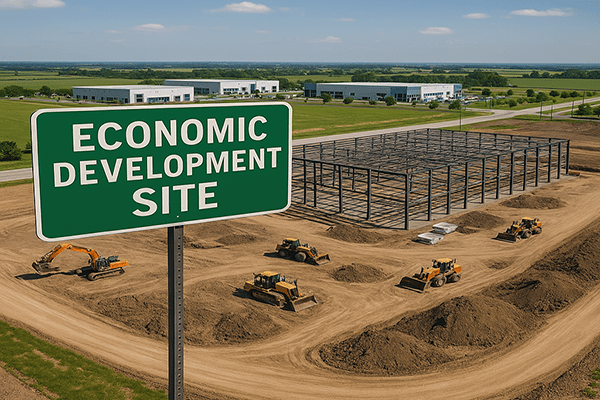|
RCBJ-Audible (Listen For Free)
|
The Weighing Of Costs And Benefits Is Fundamental To Authorizing Economic Development Incentives
By Steven Porath

In the most basic terms, an economic development project is simply a business deal… government incentives are provided to a business, and in turn, the company agrees to locate (or expand) its business in the community and agrees to make capital investments, pay its property taxes and create/retain jobs.
The “WHY” the deal is done, however, is the important part.
Promoting and maintaining a vibrant business base is critical to the well-being of the community. The services, products, jobs, property, and other taxes a business provides creates a balance of affordability and quality of life for the residential community. Financial incentives provided by the IDA are the “carrots” to attract, retain and grow the business base… especially given that the Greater New York Metro region is an expensive, competitive environment for businesses to operate profitably. If a business can operate more profitably elsewhere, it will do so. Our job, as economic developers, is to get and keep them here.
For the purpose of the article, let us set aside the eternal debate on the merits of whether a community should or should not provide financial incentives to a business… I promise to discuss that topic in the Rockland County Business Journal in a future article. For this article, let us focus on the merits of economic development projects in the context of a cost/benefit analysis… Essentially, what are we giving and what are we getting?
The Cost/Benefit Analysis:
To demonstrate the cost/benefit, let us break down the numbers of an actual, recent, Rockland IDA project… (Note: I have left the name and location out of this example since it is the analysis that is important for this article, not the merits of any one project.)
The Situation:
The owner of a long-time facility is closing the business. The 200+ jobs at the facility will cease to exist. All other economic benefits the business provides to the community will disappear. While the company would like to sell the facility to (a) another business, it has indicated that if need be, it will (b) raze the building and be taxed on vacant land (versus paying much higher taxes on an empty building); or (c) will sell to an interested buyer that would result in property taxes being greatly reduced. Clearly, for the community, option “a” provides the best economic impact.
The Economic Development Opportunity:
A well-established corporation is considering buying the facility and establishing significant operations at the site. Their intent is to create almost 400 new jobs and invest approximately $100 million+ in furniture, fixtures, equipment, and construction materials at the site.
The company notes that it is considering alternative sites in New Jersey and Pennsylvania; and also notes that economic incentives are a critical part of its decision-making process.
The IDA Process and Incentives:
The company formally applies to the IDA for incentives. The IDA board considers and approves incentives within its normal review and formal approval process. The IDA approves exempting the company from the 8.375% New York State sales tax on approximately $47 million in capital expenditures (equating to approximately $4 million in exempted sales tax), as well as a property tax abatement program that has been negotiated and approved by the local taxing entities (i.e., village, school, town, and county). The abatement program, known as a PILOT (Payment In Lieu of Taxes agreement) provides an initial reduction from full taxes starting with the initial construction period and then escalates payments upward over time to a full assessed value.
It is also important to note with an IDA PILOT, in return for providing the company with an abatement on property taxes, establishes strict guidelines requiring the company to perform as agreed. In addition, it provides the taxing entities with certainty of property taxes without concern for tax grievances or tax payments. Strong default, termination, and recapture conditions further protect the interests of the community. In this specific case, the PILOT protects the community from either a huge or complete loss in property taxes.
The Cost/Benefit:
The following is a simplified summary of the cost/benefit of the project:
Estimated Cost of Incentives for Taxpayers:
- Approximately $15 million in sales tax and property tax reductions spread over the course of the 15-year agreement.
Estimated State and Local Benefit to Taxpayers:
- Over $1 billion in payroll for both ongoing (permanent employees) and temporary (construction and vendor) workers over the course of the 15-year period.
- Approximately $7 million in sales tax revenues generated by both permanent and temporary employees.
- Approximately $60 million in income tax and other tax revenues.
- Plus the certainty of property tax revenues and a variety of both intangible and concrete benefits to the community of hosting a large business.
Cost/Benefit Ratio: Approximately 70:1 (i.e., over the course of the 15-year agreement, taxpayers will realize a benefit of $70 for every $1 provided in incentives.)
Summary:
Granted, every IDA project does not result in such dramatic high-benefit ratios, but this example is not the exception. And further note that each project is unique and evaluated on the merits of its value to the community. The quality-of-life benefit to the community of an IDA project involving a manufacturer is quite different than the community benefit of providing much-needed housing for local residents. In short, intangibles matter, too.
Ultimately, the IDA is simply a tool that helps maintain the economically healthy mix of residential, retail, commercial and industrial sectors in our community.
Steven Porath is the Executive Director of the Rockland Industrial Development Agency












